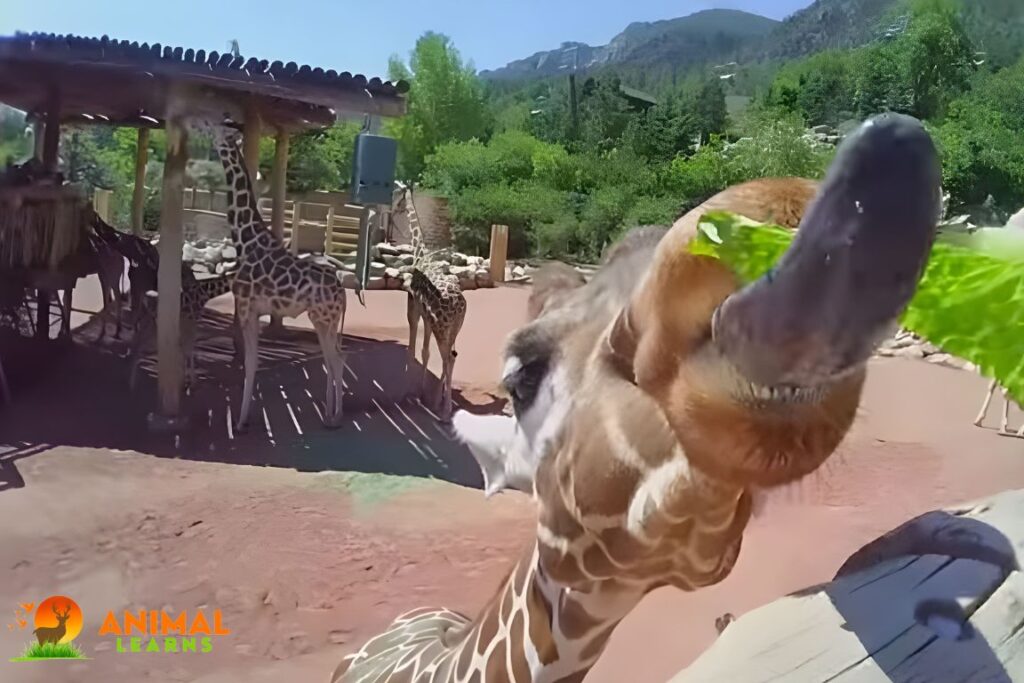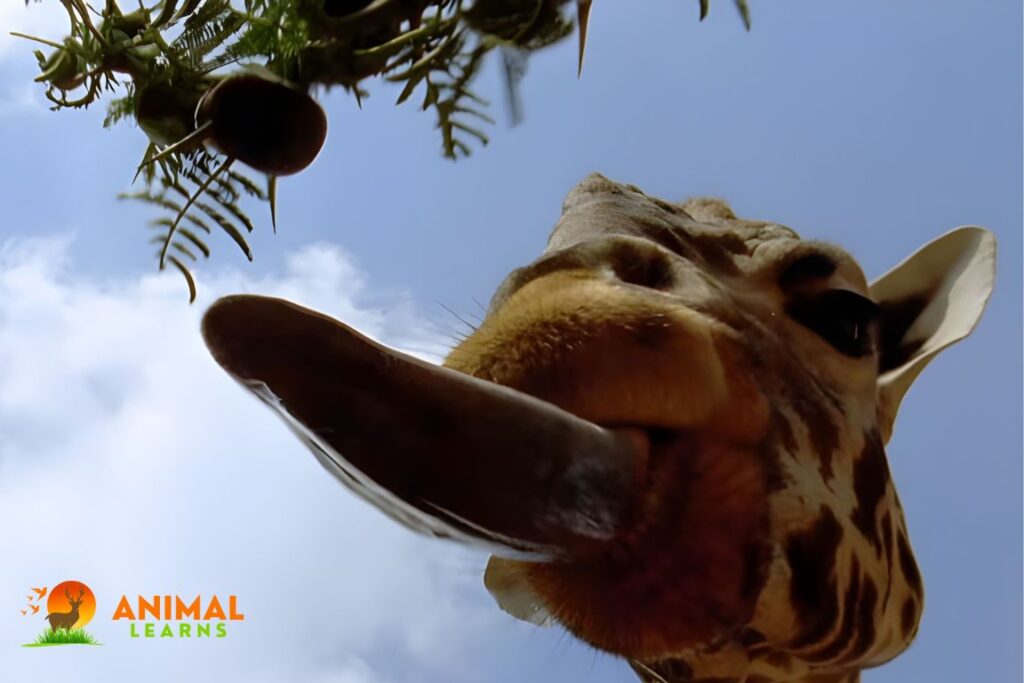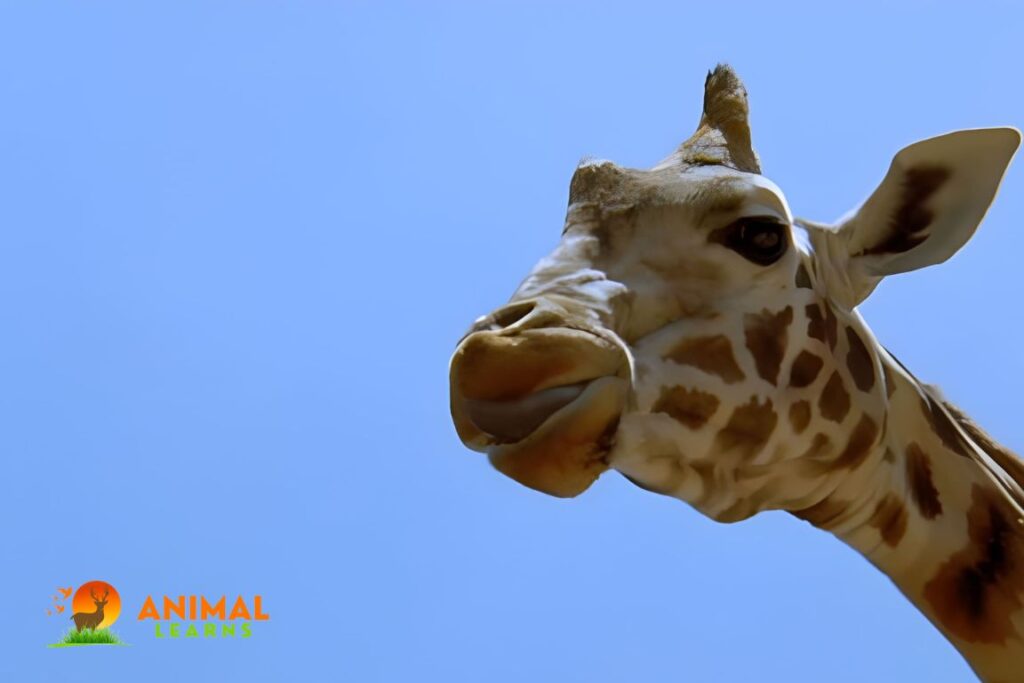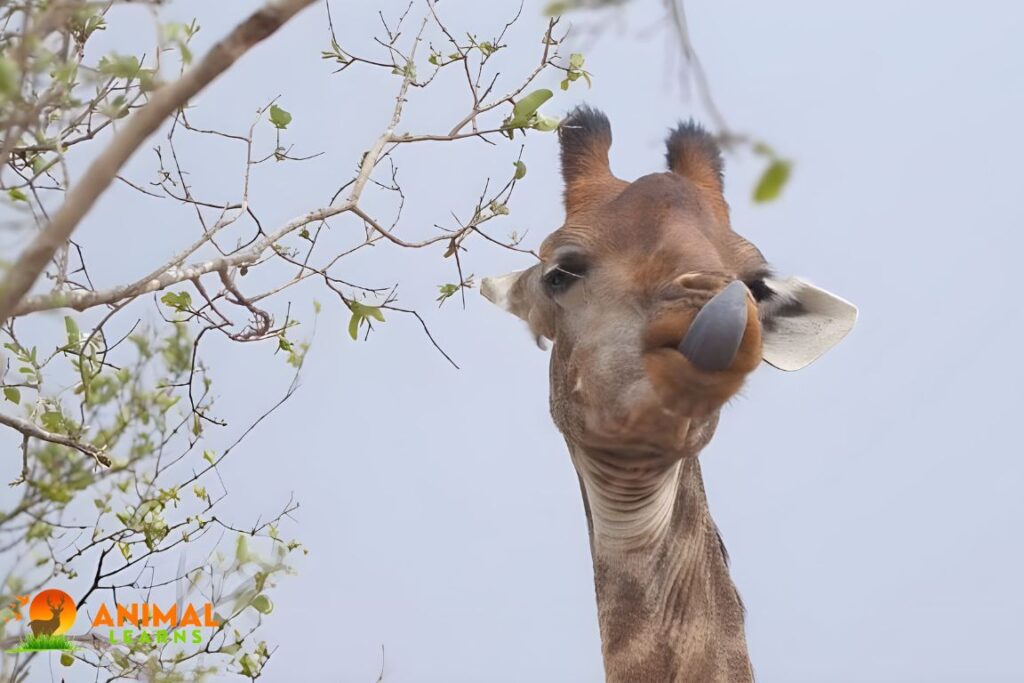10 Interesting Facts about Giraffe Tongue

| Characteristic | Information |
| Scientific Name | Giraffa camelopardalis |
| Family | Giraffidae |
| Height | 15 to 18 feet (4.5 to 5.5 meters) |
| Weight | 1,600 to 3,000 pounds (700 to 1,400 kilograms) |
| Lifespan | 20 to 25 years in the wild |
| Diet | Herbivorous, primarily leaves from trees |
| Range | African savannas, grasslands, and open woodlands |
| Natural Habitat | Sub-Saharan Africa |
| Coloration | Irregular patches on a yellowish background; the pattern is unique to each individual |
| Social Structure | Typically live in loose herds and are not territorial |
| Reproduction | Gestation period of about 15 months, usually giving birth to one calf |
| Notable Feature | Long neck, long legs, and distinctive spotted coat pattern |
The giraffe, known for its height, is an amazing animal. The Giraffe tongue is as interesting as the height of the giraffe. Its long neck adds to its beauty. It is a unique and tallest animal in the world. Its height is 18 feet. The white lines and spots on his body and face add to his beauty. His long legs play an important role in his height.
One of the most interesting features of the giraffes is their tongue. A giraffe tongue is about 18-20 inches long. The giraffe uses its long tongue as a tool to eat leaves, branches, and twigs. Giraffe tongues are often deep blue-black or bluish-purple in hue.
When they stand in the sun and eat leaves, twigs, and branches, the deep blue-black color of their tongues protects them from sunburn. In this article, we will read in detail the features of the giraffe long tongue.
10 Interesting facts: giraffes’ tongues and environment
Contents
- Giraffes use long tongues to reach high leaves.
- Their tongues act like leaf strippers.
- They are selective eaters, grasping specific leaves.
- Tough tongues protect against thorns.
- Tongues are used for social grooming and bonding.
- Giraffes can drink water using their tongues.
- Prehensile tongues grasp food in tight spots.
- Quick tongue withdrawal avoids insect bites.
- Efficient tongue feeding sustains them on a leafy diet.
- Giraffe tongues are a remarkable habitat adaptation.
Measuring the Length of a Giraffe Tongue

Length of a Giraffe’s Tongue
Have you ever wondered how long a giraffe’s tongue is? It’s one of the most fascinating features of these majestic animals. A giraffe’s tongue can be as long as 50 centimeters (20 inches), which is about the length of an average arm. Some giraffes even have tongues that are longer than that, up to 55 centimeters (22 inches). That’s almost two feet!
Comparison between Measurements:
Let’s compare the length of a giraffe’s tongue with some common objects:
| Measurement | Giraffe Tongue Length |
| Centimeters | 45-55 cm (Longer than a ruler or a banana) |
| Inches | 18-22 inches (Longer than a laptop or a skateboard) |
| Feet | 1.5-1.8 feet (Longer than a shoe or a pillow) |
Practicality and Function of Such a Long Tongue:
You might be wondering why a giraffe needs such a long tongue. Well, it’s not just for show. A giraffe’s tongue has many practical functions that help it survive and thrive in its environment:
- Foraging at Heights: Giraffes are experts at reaching for food high up in the trees, where other long tongue animals can’t get to. Their long tongues help them grab leaves, shoots, and buds from the branches without stretching their necks or bodies too much.
- Accessing Thorny Foliage: Many of the plants that giraffes eat have thorns or spikes that can hurt them. Their long tongues help them pick and pull leaves from these plants without getting injured.
- Versatile Tool: Giraffe tongues are not only long but also very flexible and agile. They can twist and curl their tongues around branches, leaves, and even small fruits or flowers, making them very efficient herbivores.
- Minimizing Competition: Giraffes’ long tongues give them an advantage over other animals that share their habitat. They can access a wider variety of foliage, reducing the competition for food with other herbivores that can’t reach the same heights. This helps them flourish in their ecosystems.
- Maintaining Balance: When a giraffe sticks out its tongue to get food from the trees, it also balances its weight, preventing it from falling over while feeding at great heights.
Giraffe Tongue Color

Giraffe tongue color is a fascinating aspect of these magnificent creatures’ biology. Unlike many other animals, giraffes don’t have one uniform tongue color; their tongues can range from blue to nearly black, with some individuals even displaying shades of purple.
The primary reason behind this unique coloration is the presence of melanin, the same pigment responsible for skin and hair color in animals. Giraffes use their tongues for various purposes, including grasping leaves from tall trees, grooming, and engaging in social interactions
A Closer Look at Giraffe Tongue in Action
what giraffes use their tongues for in the wild.
Giraffes in the wild depend on their long tongues for many kinds of uses. One essential task is finding high tree canopies for leaves, buds, and twigs that other herbivores can’t get to. it provides them access to a more expanded as well as more nutritious food production, ensuring they fulfill the needs of their bodies in their dry African surroundings.
how giraffes tongues help them survive and thrive
Their tongues further assist them in survival by allowing them to carefully handle past thorns and thorny foliage, dropping the danger of injuries when feeding. In addition, the tongue’s flexibility allows it to pick and extract the most nutritious components of plants while avoiding less desirable ones. Furthermore, giraffes‘ large mouths assist them in conserving energy.
The Adaptations of a Giraffe’s Tongue

Evolutionary Adaptation of Giraffe’s Long Tongue
The long tongue of the giraffe proposed over millions of years as forebears reached higher leaves. Longer tongues presented them a benefit in terms of survival and reproduction by enabling them to devour more nutritious food.
Natural selection favored giraffes with longer tongues, resulting in the stunning tongues we see today. It shows how evolution creates capabilities for an animal’s ecological niche and aids in its ability to survive.
Advantages of a Long Tongue for Giraffes
Giraffe tongue offers crucial benefits. They access high, varied plant species and parts, even during food shortages. This length reduces physical effort, conserving energy and preventing injuries.
Their prehensile tongues provide precision and dexterity, allowing selective plucking of the most nutritious plant parts. In sum, giraffes’ long tongues are vital tools for their herbivore success in the African savannah.
Sticking Their Tongues Out
Giraffes extend their tongues while feeding to reach high foliage, making leaf-grabbing easier and reducing the need to use their heads or necks. This also helps them avoid thorns and maintain balance at great heights.
So, when you see a giraffe with its tongue out, it’s not just a quirky behavior; it’s a clever adaptation that aids in their efficient browsing and survival.
The Science Behind Giraffe Tongues
Giraffe tongue scientific studies and studies provided important information on its unique characteristics. The texture and strength of giraffe tongues have been examined, showing their adaptation for collecting and taking leaves from trees.
Based on these results, giraffe tongue are not only lengthy but also prehensile, helping them to explore their environment with ease. Researchers examined giraffe tongue motions while eating using various ways, including high-speed cameras, identifying facts on their outstanding feeding abilities.
Such research advances our understanding of these amazing animals and the function their amazing tongues play in their survival.
The Fascination with Giraffe Tongues

Giraffe tongue have inspired a remarkable interest in popular culture, attracting the attention of people across the world. Viral videos and fascinating pictures of giraffes and their unique tongues have swept over social media platforms, providing a lovely touch to the world of online entertainment.
These viral phenomena, which frequently include giraffes sticking out their tongues or utilizing them in unexpected ways, have captivated viewers of all ages.
In addition, the fascinating facts about giraffe tongue, such as their distinct coloration, remarkable length, and versatile use in foraging, have made them a source of ongoing fascination, enriching our understanding of these fascinating creatures and the remarkable adaptations that define their existence.
FAQs
What color is a giraffe’s tongue?
A giraffe’s tongue can be in various shades of blue, black, or purple, which helps protect it from sunburn and UV radiation.
How long is a giraffe’s tongue?
A giraffe’s tongue can measure up to 18-20 inches (45-50 centimeters) on average, but it can vary between individuals.
Why do giraffes have such long tongues?
Giraffes have long tongues to reach high branches and pluck leaves from trees, their primary source of food.
Are giraffe tongues rough or smooth?
Giraffe tongues are rough due to the presence of papillae (small, finger-like structures) that help them grip and strip leaves from branches.
How do giraffes use their tongues for cleaning ears and noses?
Giraffes use their tongues to clean their ears and noses as well as to reach and groom hard-to-reach areas of their bodies, helping maintain hygiene and detect scents in their environment.












